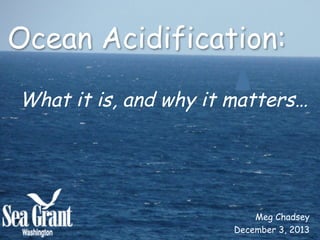New meg chadsey northwest school presentation with credits dec27
- 1. Ocean Acidification: ? What it is, and why it matters¡ ? ? Meg Chadsey December 3, 2013
- 3. Image ?courtesy ?of ?Jack ?Cook, ? Woods ?Hole ?Oceanographic ?Ins<tute ?
- 4. What is Ocean Acidification? Climate change CO2 (Carbon Dioxide) The ocean absorbs ~25% of carbon dioxide we¡¯re pumping into the atmosphere. Ocean acidification Sarah ?Cooley, ?Woods ?Hole ?Oceanographic ?Ins<tute ?
- 5. The pH Scale ??H2O ? + ?CO2 ? ¨¤? ?H2C03 ? Seawater ? Carbonic ? Acid ? Source: ?Dr. ?Simone ?Alin, ?NOAA ?PMEL ? h>p://www.pmel.noaa.gov/co2/story/A+primer+on+pH ?
- 6. Washington is Particularly Vulnerable to Acidification Appearing decades sooner than anticipated. Regional factors exacerbating the problem: Upwelling along the coast¨¤? Excess nutrients¨¤?blooms Decay of organic material Acidifying gasses (NOX and SOX) Washington ?Coast ?photo: ?Russ ?McMillan ?
- 7. Ocean Acidification means¡.. less calcium carbonate for building shells
- 8. Pteropods, or ¡®sea butterflies¡¯ are dissolving¡ Normal pteropod shell Corroded pteropod shell in acidic seawater Live ?pteropod ?image: ?Dr. ?Russ ?HopcroI, ?UofA ?Fairbanks; ?Shell ?images: ?Dr. ?Nina ?Bednarsek, ?NOAA ?PMEL ?
- 9. Also vulnerable to OA¡ Ecosystems Fish Food People Food
- 10. Potential Food Web Impacts Paci?c ?Salmon ? Coccolithophores ? Pteropods ? Copepods ?
- 11. U.S. Commercial Fisheries Affected by Ocean Acidification Primary fishery revenue ~ $4 billion/year* *2007 U.S. domestic ex-vessel revenue (USD) Mollusks (shellfish) 5% 10% About half comes from calcifiers (mollusks and crustaceans) Crustaceans (lobster,crabs and shrimp) Top Predators Other calci?ers 26% 3% 1% 1% 10% 11% 24% 9% Calci?ers¡¯ predators Oysters & mussels Lobsters Scallops About a quarter comes from species that eat calcifiers Crabs Clams Shrimp Unin?uenced Cooley ?& ?Doney ? Environment ?Research ?Le>ers, ?2009 ?
- 12. What¡¯s at Stake for our Economy? Photos: ?Benjamin ?Drummond ?(leI ?and ?right); ?Bryan ?PenWla ?(center) ? Washington commercial shellfish industry: ?? Most productive on the West Coast ?? Accounts for almost 85% of West Coast annual sales ?? Generates $270 million annually ?? Supports 3,200 jobs
- 13. What¡¯s at Stake for our Economy? (cont¡¯d) Photos: ? ?U.S. ?Dept. ?Agriculture; ? ?City ?of ?SeaXle; ?WA ?Assn. ?of ?Conserva<on ?Districts ? ? Valuable wild and recreational fisheries ?? Food web impacts could ripple through Washington¡¯s seafood industry ?? 42,000 state jobs ?? $1.7 billion annual contribution ?? Coastal communities depend on recreational shellfishing
- 14. What¡¯s at Stake for Washington¡¯s Tribes? Photos: ?Northwest ?Indian ?Fisheries ?Commission ? Cultural and economic survival ?? Washington tribes depend upon shellfish for food, income, and connection to their cultural heritage. Photos: ?Northwest ?Indian ?Fisheries ?Commission ?
- 15. The Blue Ribbon Panel on Ocean Acidification ?? Convened by Governor Christine Gregoire in February 2012. ?? A first-of-a-kind state-level effort ?? Panel charge: ?? Review best available science ?? Recommendations for response ?? Included: ?? scientists ?? decision makers ?? industry stakeholders ?? tribal representatives ?? conservation community Photo: ?Puget ?Sound ?Partnership ? Gov. Gregoire and Bill Dewey of Taylor Shellfish Company discuss oyster farming in the tide flats in Samish Bay.
- 16. What should we do about OA? ¡°Nowhere on our planet is a local response to ocean acidification more urgently and immediately needed than here in Washington State.¡± ~ Dr. Jane Lubchenco, NOAA Administrator, Nov 27, 2012 ? ¡°The cost of responding to ocean acidification may be substantial, but it is still far less than the costs of inaction. Responding to ocean acidification will require a sustained effort ¨C there¡¯s no silver bullet solution.¡± ~ Bill Ruckelshaus, Blue Ribbon Panel co-chair, Nov. 27, 2012 ? ¡°Washington can lead.¡± ~ Governor Gregoire, Nov 27, 2012
- 17. Panel Recommendations 1.? Reduce CO2 emissions 2.? Reduce land-based pollutants that worsen OA 3.? Foster adaptation and remediation to protect the shellfish industry and marine ecosystems; 4.? Increase research and monitoring 5.? Inform, educate, and engage 6.? Maintain a sustained and coordinated focus on OA Photo: ?Dan ?BenneX ?
- 18. State Legislature Funds OA Response $1.82 million for Washington Center on OA ?? Continued water quality monitoring at shellfish hatcheries¡ ($150K) ?? Expanded OA monitoring¡ ($475K) ?? Laboratory studies to assess direct causes and effects of OA¡ ($170K) ?? Develop short-term forecasting ability¡ ($325K) ?? Develop strategies to protect shellfish larvae in hatcheries... ($100K)
- 19. Thank You! Photo: ?MaX ?Chadsey ?



















